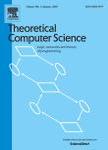版权所有:内蒙古大学图书馆 技术提供:维普资讯• 智图
内蒙古自治区呼和浩特市赛罕区大学西街235号 邮编: 010021

作者机构:Univ Bordeaux LaBRI UMR CNRS 5800 Bordeaux INP 351 Cours Liberat F-33405 Talence France
出 版 物:《THEORETICAL COMPUTER SCIENCE》 (理论计算机科学)
年 卷 期:2019年第780卷第0期
页 面:20-28页
核心收录:
学科分类:08[工学] 0812[工学-计算机科学与技术(可授工学、理学学位)]
主 题:Beeping model Size computation Counting problem Las Vegas algorithms
摘 要:We consider networks of processes which interact with beeps. In the basic model defined by Cornejo and Kuhn [8], which we refer to as the BL variant, processes can choose in each round either to beep or to listen. Those who beep are unable to detect simultaneous beeps. Those who listen can only distinguish between silence and the presence of at least one beep. Beeping models are weak in essence and even simple tasks may become difficult or unfeasible with them. In this paper, we address the problem of computing how many participants there are in a one-hop network: the counting problem. We first observe that no algorithm can compute this number with certainty in BL, even if it is randomised (Las Vegas). We thus consider the stronger variant where beeping nodes are able to detect simultaneous beeps, referred to as BcdL (cd stands for collision detection). We prove that at least n rounds are necessary in BcdL, and we present an algorithm whose running time is O(n) rounds with high probability. Further experimental results show that its expected running time is less than 10n. Finally, we discuss how this algorithm can be adapted in other beeping models. In particular, we show that the algorithm can be emulated in BL, at the cost of a logarithmic slowdown and of trading its Las Vegas nature (certain result, uncertain time) against a Monte Carlo one (certain time, uncertain result). (C) 2019 Published by Elsevier B.V.